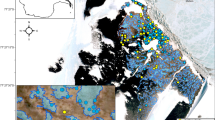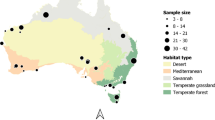Abstract
Predators account for lethal effects in their prey, but importantly also for non-lethal indirect effects through the presence and the activity of predators. Such non-lethal effects include altered timing of reproduction, incidence of reproduction, clutch size and quality of offspring produced. We investigated the effects of goshawks Accipiter gentilis on reproduction of the stock dove Columba oenas in 1723 breeding events during 2006–2015 in Northern Denmark, while simultaneously accounting for effects of climate on reproduction of stock doves. Stock doves were consumed by goshawks 36 times less frequently than expected from their abundance, showing that lethal effects of predation were negligible. Laying date advanced at higher temperatures and stronger winds. Laying was delayed when the population size of goshawks increased, and the effects of goshawks interacted wind speed. The frequency of eggs that did not hatch increased with the population size of goshawks, and with increasing temperatures. Recruitment rate of stock doves decreased with increasing population size of goshawks and stock doves. These findings show that indirect effects of predation by goshawks on stock doves were much larger than direct lethal effects and that climate change interacted with predator–prey interactions.


Similar content being viewed by others
References
Abrams PA (1984) Foraging time optimization and interactions in food webs. Am Nat 124:80–96
Abrams PA (1991) Strengths of indirect effects generated by optimal foraging. Oikos 62:167–176
Abrams PA, Matsuda H (1996) Positive indirect effects between prey species that share predators. Ecology 77:610–616
Balbontín J, Møller AP (2015) Environmental conditions during early life accelerate the rate of senescence in a short-lived passerine bird. Ecology 96:948–959
Begon M, Harper JL, Townsend CR (1996) Ecology. Blackwell, Oxford
Charmantier A, McCleery RH, Cole LR, Perrins C, Kruuk LEB, Sheldon BC (2008) Adaptive phenotypic plasticity in response to climate change in a wild bird population. Science 320:800–803
Clavero M, Villero D, Brotons L (2011) Climate change or land use dynamics: do we know what climate change indicators indicate? PLoS One 6(4):e18581
Clutton-Brock TH (ed) (1988) Lifetime reproduction. University of Chicago Press, Chicago
Cohen J (1988) Statistical power analysis for the behavioral sciences, 2nd edn. Lawrence Erlbaum, Hillsdale
Cramp S, Perrins CM (eds) (1980) The Birds of the Western Palearctic, vol 2. Oxford University Press, Oxford
Cramp S, Simmons KEL (eds) (1985) The Birds of the Western Palearctic, vol 5. Oxford University Press, Oxford, UK
Crowl TA, Covich AP (1990) Predator-induced life history shifts in a freshwater snail. Science 247:949–951
Dobson AP, Hudson PJ (1992) Regulation and stability of a free-living host-parasite system: Trichostrongylus tenuis in Red Grouse. 2. Population models. J Anim Ecol 61:487–498
Dulvy NK, Freckleton RP, Polunin NVC (2004) Coral reef cascades and the indirect effects of predator removal by exploitation. Ecol Lett 7:410–416
Eglington SM, Pearce-Higgins JW (2012) Disentangling the relative importance of changes in climate and land-use intensity in driving recent bird population trends. PLoS One 7(3):e30407
Herfindal I, van de Pol M, Nielsen JT, Sæther B-E, Møller AP (2015) Climatic conditions cause complex patterns of covariation between demographic traits in a long-lived raptor. J Anim Ecol 84:702–711
Hik DS (1995) Does the risk of predation influence population dynamics: evidence from the cyclic decline of snowshoe hares. Wildl Res 22:115–129
Huhta E, Rytkönen S, Solonen T (2003) Plumage brightness of prey increases predation risk: an among-species comparison. Ecology 84:1793–1799
Julliard R, McCleery RH, Clobert J, Perrins CM (1997) Phenotypic adjustment of clutch size due to nest predation in the great tit. J Anim Ecol 78:394–404
Kampichler C, van Turnhout CAM, Devictor V, van der Jeugd HP (2012) Large-scale changes in community composition: determining land use and climate change signals. PLoS One 7(4):e35272
Kenward R (2006) The goshawk. Poyser, London
Krebs CJ, Boutin S, Boonstra R, Sinclair ARE, Smith JNM, Dale MRT, Martin K, Turkington R (1995) Impact of food and predation on the Snowshoe Hare cycle. Science 269:1112–1115
Lima SL (1998) Nonlethal effects in the ecology of predator–prey interactions: what are the ecological effects of antipredator decision-making? BioSci 48:25–34
Lima SL, Dill LM (1990) Behavioural decisions made under the risk of predation: a review and prospectus. Can J Zool 68:619–640
Lüning J (1992) Phenotypic plasticity of Daphnia pulex in the presence of invertebrate predators: morphological and life history responses. Oecologia 45:110–117
Mantyka-Pringle CS, Martin TG, Rhodes JR (2012) Interactions between climate and habitat loss effects on biodiversity: a systematic review and meta-analysis. Global Change Biol 18:1239–1252
Martin Y, van Dyck H, Dendoncker N, Titeux N (2013) Testing instead of assuming the importance of land use change scenarios to model species distributions under climate change. Global Ecol Biogeogr 22:1204–1216
McCleery RH, Clobert J, Julliard R, Perrins CM (1996) Nest predation and delayed cost of reproduction in the great tit. J Anim Ecol 65:96–104
Møller AP, Jennions MD (2002) How much variance can be explained by ecologists and evolutionary biologists? Oecologia 132:492–500
Møller AP, Nielsen JT (2006) Prey vulnerability in relation to sexual coloration of prey. Behav Ecol Sociobiol 60:227–233
Møller AP, Nielsen JT (2007) Malaria and risk of predation: a comparative study of birds. Ecology 88:871–881
Møller AP, Flensted-Jensen E, Mardal W (2007) Agriculture, fertilizers and life history of a coastal seabird. J Anim Ecol 76:515–525
Møller AP, Solonen T, Byholm P, Huhta E, Nielsen JT, Tornberg R (2012) Spatial consistency in susceptibility of prey species to predation by two Accipiter hawks. J Avian Biol 43:390–396
Møller AP, Flensted-Jensen E, Laursen K, Mardal W (2015) Fertilizer leakage to the marine environment, ecosystem effects and population trends of waterbirds in Denmark. Ecosystems 18:30–44
Nakagawa S, Cuthill IC (2007) Effect size, confidence interval and statistical significance: a practical guide for biologists. Biol Rev 82:591–605
Newton I (1998) Population Limitation in Birds. Academic, London
Nielsen JT, Drachmann J (1999) Prey selection of Goshawks Accipiter gentilis during the breeding season in Vendsyssel, Denmark. Dansk Ornitol Foren Tidss 93:85–90
Norrdahl K, Korpimaki E (2000) The impact of predation risk from small mustelids on prey populations. Mamm Rev 30:147–156
Opdam P, Wascher D (2004) Climate change meets habitat fragmentation: linking landscape and biogeographical scale levels in research and conservation. Biol Cons 117:285–297
Peacor SD, Werner EE (2001) The contribution of trait-mediated indirect effects to the net effects of a predator. Proc Natl Acad Sci USA 98:3904–3908
Pimm SL (2009) Climate disruption and biodiversity. Curr Biol 19:R595–R601
Reznick DN, Bryga H, Endler JA (1990) Experimentally induced life history evolution in a natural population. Nature 346:357–359
SAS (2012) JMP version 10.0. SAS Institute Inc., Cary
Werner EE, Anholt BR (1996) Predator-induced behavioural indirect effects: consequences to competitive interactions in anuran larvae. Ecology 77:157–169
Wootton JT (1994) The nature and consequences of indirect effects in ecological communities. Ann Rev Ecol Syst 25:443–466
Acknowledgments
We thank the landowners for access to their properties. J. Sundell and an anonymous reviewer provided constructive comments.
Author contribution statement
APM conceived and designed the study. EFJ and JTN collected the data. APM analyzed the data. APM with the help of all other authors wrote the manuscript.
Author information
Authors and Affiliations
Corresponding author
Additional information
Communicated by Janne Sundell.
Rights and permissions
About this article
Cite this article
Møller, A.P., Flensted-Jensen, E. & Nielsen, J.T. Indirect effects of the generalist avian predator, the goshawk, on life history of an uncommon prey species, the stock dove. Oecologia 182, 1045–1052 (2016). https://doi.org/10.1007/s00442-016-3709-z
Received:
Accepted:
Published:
Issue Date:
DOI: https://doi.org/10.1007/s00442-016-3709-z




